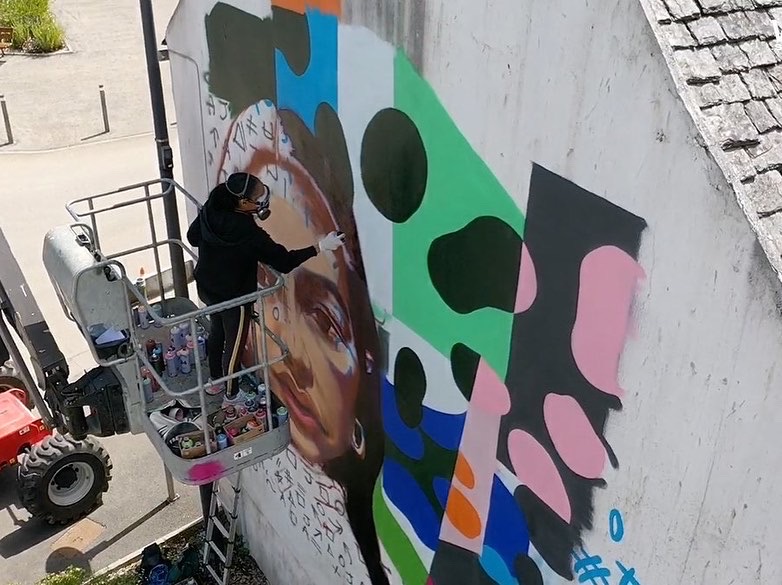Only a few artists possess the ability to reach deep into the human soul and pluck the strings of memory and emotion with the same finesse as Jomad. Her canvases and sculptures are not mere works of art; they are portals to moments frozen in time, encapsulating the essence of life itself. In a recent interview with Jomad, we embarked on a journey through her artistic evolution, exploring her connection to Tupac Shakur, her innovative fusion of painting and sculpture, and the profound significance of preserving memories through art.

A Universal Connection: Tupac Shakur
Art has the remarkable power to bridge cultures, experiences, and dreams. Jomad’s exploration of Tupac Shakur in her artwork exemplifies this universal appeal. Her portrayal of Tupac goes beyond a simple artistic endeavour—it’s a channel through which she connects to American life and the dream it represents. As she notes, “We are all part of American life because we all have the opportunity to learn from the American dream through TV.” Through her husband’s Californian roots, she adopts an attitude and perception of life that outstrips borders, finding love, joy, and dreams in this shared narrative.
In Jomad’s art, we witness the way creativity unites diverse worlds, reminding us that art is a universal language that can break down barriers and inspire connection.

The Fusion of Painting and Sculpture
One of the most striking aspects of Jomad’s art is her seamless blend of painting and sculpture. Her work is a captivating dance of colours and forms that evokes emotions and tells stories. But how did she discover this unique fusion, and what inspired her to explore the relationship between these two mediums?
For Jomad, it all comes down to the concept of value. At the outset of her artistic journey, she grappled with questions about her own worth as an artist. She was not confined to a single medium, and she decided to paint because it was a personal choice that brought her joy and allowed her to inspire others. In her words, “It’s all about value, not ego, because you always have something to learn from people.” This humility and openness to learning is what distinguishes Jomoad as an artist—her willingness to embrace her own value and that of others.
Sculpture came later in her creative evolution as she sought to infuse her work with stronger materials, volume, and perception. This transition from plaster to ceramics was driven by her daily interactions with people who filled her life with a spectrum of emotions. It’s evidence of the power of human connection and experience in shaping art.

The Creative Process: A Journey of Self-Discovery
Jomad’s creative process is as unique and fluid as her art. She shares insights into her transition from one medium to another, illustrating how her emotions and movements guide her work. She began with spray paint, an expressive form of street art that allowed her to explore the movement of her body. The streets became her canvas, and her movements spoke the language of her emotions.
As she shifted to acrylics for her paintings, she discovered a different movement, one that necessitated larger canvases. For Jomad, size matters—it’s about making a bold statement, inviting viewers to immerse themselves in the world she creates. Her process, she acknowledges, will always remain experimental, guided by the tools she uses and the emotions she feels.
Jomad’s creative journey signals that art is a reflection of the self, a canvas upon which we paint our emotions and experiences, adapting and evolving with each stroke.

The Wellspring of Jomad’s Inspiration
At the heart of Jomad’s art is her imagination. She explains that inspiration often comes from her dreams and her acute awareness of the world’s unfolding dramas. Her art becomes a vehicle to respond to these “crazy things” happening in different countries. Through her work, she aspires to distil something profoundly potent into mere seconds—something that can uplift and inspire. Jomad’s deepest wish is to contribute positively to the world and inspire people in a meaningful way.
When chaos and noise drown out the softer voices within, Jomad’s art tells us to listen to our inner imaginations, to be conscious of the world around us, and to use our creativity to make a positive impact.


The Essence of Jomad’s Art: Preserving Memories
Jomad’s art captures moments frozen in time, painting scenes that range from a woman caring for her family to a group of friends celebrating life. Her work serves as a reminder of the preciousness of life’s fleeting moments and the stories that define us.
Jomad’s innovative use of cylindrical shapes adds an astonishing depth of emotion to her work. These shapes manifest movement, akin to a candle’s flicker. They serve as a celebration of life itself, a profound acknowledgment that death is an integral part of existence. In Jomad’s world, when someone passes away, it is not met with sorrow alone, but with days and weeks of celebration.
Memory as a Unifying Thread
In her limited-edition series, Jomad explores the strength that lies in memories and how they are created. Her pieces draw from the archives of her own family’s recollections: aunts rising with the dawn to prepare meals, friends gathering for lively parties, and uncles engaged in spirited games of dominoes. Through these memories, she encourages us to pay attention to our own, to find common ground with others, and to discover shared experiences that bind us together.

Tackling Depression Through Noise Cancelling Art
In our modern, relentlessly busy lives, mental stress has become an all-too-common companion. The constant buzz of notifications, the ceaseless demands of work and life, and the ever-present weight of expectations can leave us mentally exhausted and emotionally drained. In this chaotic orchestra of daily stressors, art can serve as a powerful conductor of calm and mindfulness.
Much like noise-cancelling headphones block out the cacophony of a crowded street, art has the potential to silence the internal chaos of our minds. It offers a sanctuary, a visual and creative escape where the relentless hum of life fades into the background. Engaging with art, whether it’s creating, observing, or even simply appreciating it, can be a therapeutic act. Find more insight in our previous article, Beyond Aesthetics: The Therapeutic Benefits of Art on Mental Health.
Many, due to fear of being criticised, will often veil their emotions in silence. One of the most profound aspects of Jomad’s work is her willingness to engage with emotions openly. Jomad speaks to a generation that is learning to articulate its struggles, dismantling the barriers of stoicism that once held sway.
She recognises that in previous generations, discussing anxiety and mental health was often taboo. However, times are changing, and she encourages the younger generation to be vocal about their struggles. Jomad believes in the transformative power of emotions and the healing journey that can begin when we open up and connect with others. So, in the midst of life’s overwhelming noise, consider turning to the quiet power of art.
Conclusion
As we navigate the complexities of our modern world, we must recognise the profound impact that art and open expression can have on our lives. Jomad’s art encourages us to pause, reflect, and cherish the moments that have shaped us. It prompts us to celebrate life and to be open about our anxieties and emotions, fostering connections and empathy. Simply put, it reminds us that, in the end, it’s our memories and emotions that truly define our humanity.











